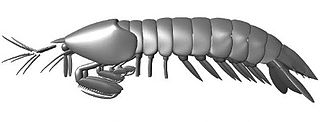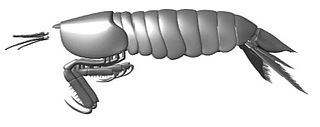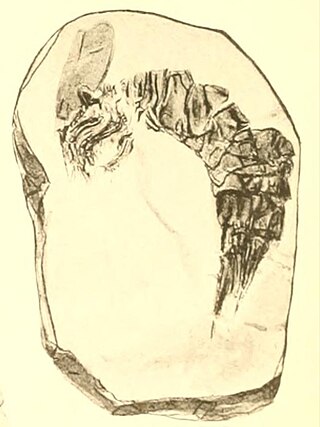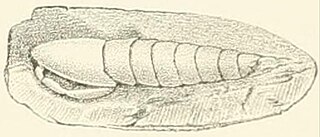
The Solnhofen Limestone or Solnhofen Plattenkalk, formally known as the Altmühltal Formation, is a Jurassic Konservat-Lagerstätte that preserves a rare assemblage of fossilized organisms, including highly detailed imprints of soft bodied organisms such as sea jellies. The most familiar fossils of the Solnhofen Plattenkalk include the early feathered theropod dinosaur Archaeopteryx preserved in such detail that they are among the most famous and most beautiful fossils in the world. The Solnhofen beds lie in the German state of Bavaria (Bayern), halfway between Nuremberg (Nürnberg) and Munich (München) and were originally quarried as a source of lithographic limestone. The Jura Museum situated in Eichstätt, Germany has an extensive exhibit of Jurassic fossils from the quarries of Solnhofen and surroundings, including marine reptiles, pterosaurs, and one specimen of the early bird Archaeopteryx.

Yohoia is an extinct genus of megacheiran arthropod from the Cambrian period that has been found as fossils in the Burgess Shale formation of British Columbia, Canada. The type species, Yohoia tenuis, was described in 1912 by Walcott, who considered it an anostracan crustacean. 711 specimens of Yohoia are known from the Greater Phyllopod bed, where they comprise 1.35% of the community. In 2015, Conway Morris et al. reported another species, Y. utahana, from the Marjum Formation, Utah.

Megacheira is an extinct class of predatory arthropods defined by their possession of spined "great appendages". Their taxonomic position is controversial, with studies either considering them stem-group euarthropods, or stem-group chelicerates. The homology of the great appendages to the cephalic appendages of other arthropods is also controversial. Uncontested members of the group were present in marine environments worldwide from the lower to middle Cambrian.

Lysiosquillina maculata, the zebra mantis shrimp, striped mantis shrimp or razor mantis, is a species of mantis shrimp found across the Indo-Pacific region from East Africa to the Galápagos and Hawaiian Islands. At a length up to 40 cm, L. maculata is the largest mantis shrimp in the world. L. maculata may be distinguished from its congener L. sulcata by the greater number of teeth on the last segment of its raptorial claw, and by the colouration of the uropodal endopod, the distal half of which is dark in L. maculata but not in L. sulcata. A small artisanal fishery exists for this species.

The Solnhofen Plattenkalk, a collective term of multiple Late Jurassic lithographic limestones in southeastern Germany, is famous for its well preserved fossil flora and fauna dating to the late Jurassic.
Aeschronectida is an extinct order of mantis shrimp-like crustaceans which lived in the Mississippian subperiod in what is now Montana. They exclusively lived in the Carboniferous, or the age of amphibians. They have been found mostly in the U.S. and in the British Isles, in 1979 species were found in the Madera Formation in New Mexico. Aeschronectida was first identified appearing in Continental Europe in around 2014. While sharing similar characteristics to Stomatopoda, they lack certain physical characteristics of that taxon. The first species of Aeschronectida is accredited to Frederick R. Schram. They diverge substantially from typical hoplocaridan morphology by having more unmodified thoracopods. It's theorized that these thoracopods evolved to become more specialized, making them potential ancestors to Stomatopoda.

Crustaceans may pass through a number of larval and immature stages between hatching from their eggs and reaching their adult form. Each of the stages is separated by a moult, in which the hard exoskeleton is shed to allow the animal to grow. The larvae of crustaceans often bear little resemblance to the adult, and there are still cases where it is not known what larvae will grow into what adults. This is especially true of crustaceans which live as benthic adults, more-so than where the larvae are planktonic, and thereby easily caught.

Coxoplectoptera or "chimera wings" is an extinct order of stem-group mayflies containing one family, Mickoleitiidae. Together with mayflies (Ephemeroptera), Coxoplectoptera are assigned to the clade Heptabranchia.

Cancrinos is a genus of fossil crustaceans closely allied with the slipper lobsters. One species is known, C. claviger from the Jurassic of southern Germany.

Santanmantis is an extinct genus of mantises, the sole genus in the family Santanmantidae. The only species, Santanmantis axelrodi, is known from the Crato Formation of Brazil, dating to the late Aptian stage of the Early Cretaceous. It is amongst the most primitive known lineages of mantis. Like other mantises, the forelegs are modified into spined raptorial appendages. When describing a new specimen in 2017, Hörnig, Haug and Haug proposed that the second set of legs also had spines similar to the forelegs, and also served a raptorial function, but that they were not visible in the fossil due to being broken off. However a response to this paper criticised this assumption, finding that it had little evidence from the fossil itself or from living mantises.
Triassosculda is an extinct genus of mantis shrimp from the Early Triassic aged Paris biota of Idaho. Its discovery bridged a 100-million-year gap in mantis shrimp evolution from the late Carboniferous to the Jurassic. Its only species is T. ahyongi.

Tyrannophontes is an extinct genus of mantis shrimp that lived during the late Carboniferous period in what is now the Mazon Creek fossil beds of Illinois. It is the only genus in the family Tyrannophontidae. The type species, T. theridion, was described in 1969 by Frederick Schram. A second, much larger species, T. gigantion, was also named by Schram in 2007. Two other species were formerly assigned to the genus, but have since been reclassified.

Daidal is an extinct genus of mantis shrimp that lived during the Carboniferous period. It is the only genus in the family Daidalidae. Three species are currently placed within the genus. Fossils of the type species, D. acanthocercus, have been found in the Bear Gulch Limestone of Montana. A second species, D. pattoni, is known from the Lower Limestone Formation of Scotland, and the third species, D. schoellmanni, was discovered in Westphalia, Germany. The genus has been proposed to be polyphyletic, with D. pattoni possibly being an earlier diverging lineage, though more specimens and research are needed to confirm this.

Sculda is an extinct genus of mantis shrimp known from the late Jurassic to late Cretaceous of Germany and Lebanon. Although several species have been assigned to it, some are now deemed dubious or moved to different genera. It was a moderate-sized crustacean, measuring no more than 50 mm (2.0 in) long. Sculda would have lived in a marine environment and been a predatory animal, likely smashing its prey with the widened segment of its raptorial appendages before cutting it with the sharp appendage tips.

Gorgonophontes is an extinct genus of mantis shrimp that lived during the late Carboniferous period in what is now the United States and Belgium. It contains two named species. The type species, G. peleron, was described in 1984 by Frederick Schram based on 100 specimens found in Nebraska and Iowa. A second species, G. fraiponti, was first named from multiple specimens found near Liège in 1922 and later reassigned to the genus.
Chabardella is an extinct genus of mantis shrimp which lived during the Late Carboniferous in France. It was named in 2009, with C. spinosa as the type and only species.

Bairdops is an extinct genus of mantis shrimp that lived during the Early Carboniferous period in what is now Scotland and the United States. Two named species are currently assigned to it. The type species, B. elegans, has been collected from several Dinantian-aged localities in Scotland, and was first described in 1908 by British geologist Ben Peach as a species of Perimecturus. The generic name was coined decades later in 1979 by American paleontologist Frederick Schram, and honors William Baird. A later species, B. beargulchensis, was named in 1978 after the Serpukhovian-aged Bear Gulch Limestone of Montana where it was discovered. The two species were originally deemed close relatives based on their physical similarities, but several cladistic analyses published since 1998 have suggested the genus may be polyphyletic.

Perimecturus is an extinct genus of mantis shrimp that lived during the Early Carboniferous period in what is now Scotland and the United States. The first known specimens were collected near the River Esk in Glencartholm, Scotland, and the genus was named in 1908 by Ben Peach, making it the second genus of Paleozoic mantis shrimp to be described. While many species have been classified in the genus since then, taxonomic revisions in the late 20th and 21st centuries have reassigned most of these to different genera, leaving two named species currently assigned to this genus. The type species, P. parki, was first named in 1882 as a species of Anthrapalaemon and is known from the Viséan-aged Glencartholm Volcanic Beds of Scotland. Fossils of a later species, P. rapax, have been found in the Bear Gulch Limestone of Montana and were first described by Frederick Schram.

Archaeocaris is an extinct genus of mantis shrimp that lived in North America during the Early Carboniferous period. Though it was placed as a member of the family Perimecturidae until 2008, it is currently deemed the only genus in the family Archaeocarididae, and contains two species. The type species, A. vermiformis, was described by Fielding Bradford Meek in 1872 from specimens collected at the base of the Waverly Group in Kentucky. A second species, A. graffhami, was named by Harold Kelly Brooks in 1962 based on a fossil found in the Caney Shale of Oklahoma, with additional remains later found in the Pilot Shale of Nevada.
Nodosculda is an extinct genus of mantis shrimp that lived in North America during the late Albian stage of the Early Cretaceous period, between 105 and 100 million years ago. The only species is Nodosculda fisherorum, known from several specimens uncovered in the Paw Paw Formation of Texas.


















